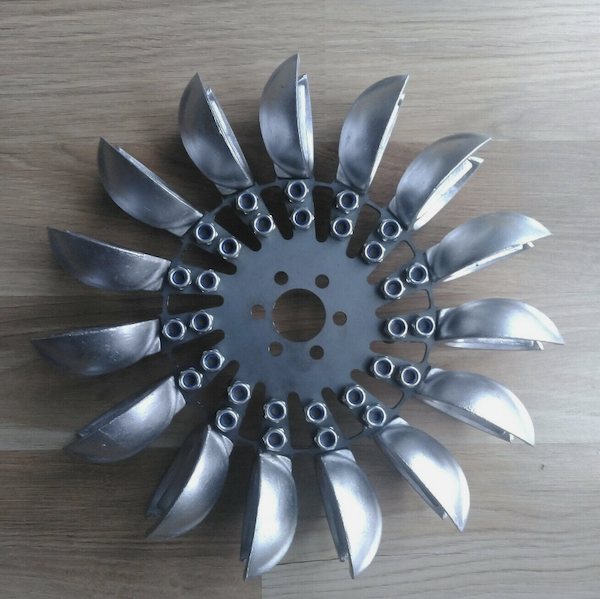From A to Z: Pelton Turbine Features
Pelton turbine, a type of impulse turbine, converts the kinetic energy of high-pressure water into mechanical energy. Thanks to the parts of the Pelton turbine, which consist of a valve, buckets, shaft, generator, and protective casing, energy production is carried out. The Pelton water turbine, frequently used in hydroelectric power plants, is particularly suitable for high-head conditions. You can find answers to your questions like what is a Pelton type turbine, and how does it work in our content, and learn about its suitability for your applications.
What is a Pelton Turbine?
The question of what a Pelton turbine is can be answered on several levels. Firstly, these turbine types are among the impulse turbines. In these turbines, the rotation of the turbine is achieved as a result of the change in water velocity caused by the impact of a water jet. The kinetic energy turns into mechanical energy as a result of the water jet hitting the blades. As one of the impulse turbines, the Pelton turbine operates in this manner. These turbines are generally used in areas with a head above 300 meters. In other words, Pelton turbines can be preferred at very high head levels.
About Lester Pelton, The Inventor of the Pelton Turbine
Lester Pelton (1829 – 1908) was a significant inventor born in the USA, who made important contributions to the development of hydroelectricity worldwide. In the late 1870s, he invented the Pelton turbine, which was the most efficient design of the impulse water turbine at the time. In the late 1870s, Pelton modeled, tested, and produced the first turbine wheel, called the “Pelton Runner.” In 1878, he installed the first operational Pelton wheel at the Mayflower Mine in Nevada City. Pelton’s ideas for improving the turbine design came from his work on mining equipment and operations in California’s Gold Rush region.
Prominent Features of the Pelton Turbine
Among the features of the Pelton turbine, its ability to operate under high-head conditions stands out. Additionally, it can be preferred in places with low flow rates. These turbines, which use high-pressure water jets, convert energy into mechanical energy as efficiently as possible. From this perspective, the Pelton turbine is known for its efficiency since the kinetic energy of water can be converted into mechanical energy at nearly a 100% rate. Due to its structure, it is frequently used especially in hydroelectric power plants in mountainous regions.
Working Principle of the Pelton Turbine
The working principle of the Pelton turbine is quite simple. In these types of turbines, high-speed water jets are emitted from nozzles surrounding the turbine. These high-speed water jets are created by pushing high-pressure water (like water falling from high peaks) through nozzles. These nozzles are designed to maximize the kinetic energy of the water. Maximum efficiency from the Pelton turbine can be achieved when the thrust obtained by the blades is at its maximum. When the water jet hits the Pelton turbine, a propulsive force emerges. This force makes the turbine rotate. The rotational motion is then transferred to the generator, and mechanical energy is converted into electrical energy.
Design
The Pelton turbine has a quite simple design. A large circular disc is mounted on a rotating shaft, known as the rotor. Blades are integrated into this circular disk at equal intervals around the entire wheel. Nozzles are also placed on the wheel and serve the purpose of delivering water to the turbine. Water jets emerge from these nozzles towards the turbine wheel, which causes the turbine to rotate.
Parts of the Pelton Turbine Nozzle and Flow Control Valve:
One of the most important components for the operation of the Pelton turbine. Water gushes out at high speed from a part called a nozzle, and the turbine starts operating. The nozzle also functions to maximize the kinetic energy of the water. The flow control valve adjusts the amount of water entering the turbine, thus the speed of the turbine and the power generated can be controlled.
Buckets: The high-speed water jet coming out of the nozzle hits the special bucket rotating around the turbine. These buckets are parts that convert the kinetic energy of water into mechanical energy. Buckets direct the water to both sides due to their surfaces and enable the turbine shaft to rotate.
Turbine Shaft (Runner): The high-speed water jet that hits the buckets causes the turbine shaft to rotate. This rotation transfers mechanical energy to the generator.
Generator: The generator, to which mechanical energy is transferred, converts this energy into electrical energy.
Protective Casing (Casing): Finally, there is a casing that protects all parts of the Pelton turbine. This casing also ensures the water flows in the correct direction within the turbine. Advantages & Disadvantages Pelton turbines have multiple advantages and disadvantages. Below you can find these details for your information:
Advantages: High efficiency is among the most significant advantages of Pelton turbines. They can achieve high efficiency rates since they operate under high-head conditions. Thus, the kinetic energy of water can be converted into electrical energy at the maximum level. Its simple design and long-term use are also important advantages.
Disadvantages: Pelton turbines offer limited use because they are only suitable for high-head conditions. Meeting high-head conditions can also introduce significant costs. There is also a risk of cavitation (the formation of vapor bubbles in a liquid in low-pressure areas) in Pelton turbines. Finally, they may have negative impacts on the environment and ecology.

